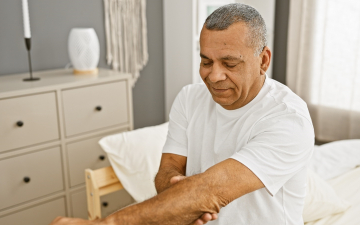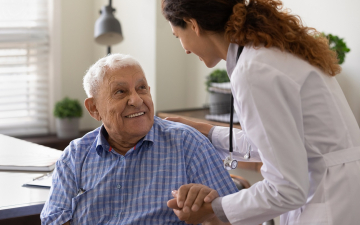
Respiratory patients with COPD often present with symptoms such as breathlessness and reduced exercise capacity, affecting their quality of life. [1]
Pharmaceutical interventions for COPD patients can reduce symptoms and reduce the frequency and severity of exacerbations.[1] Further, there is evidence that pulmonary rehabilitation can improve symptoms and quality of life.[2]
Patients who have experienced self-management interventions such as action plans have been found to be at a lower risk of respiratory-related hospitalisation.[3]
Typically, non-medical interventions can include:[1]
- pulmonary rehabilitation (PR)
- smoking cessation
- immunisation
For those patients hospitalised, care bundles are often used to ensure these interventions are discussed with patients.[1] However, most of the interventions can be initiated or supported by both primary and secondary care.
Pulmonary rehabilitation
Over the years there has been extensive randomised controlled trials and evidence showing the effectiveness of PR in people with COPD so much so that studies now suggest further research comparing PR and conventional care is not warranted.[2]
Despite this, patients are still not being referred. Less than 10–15% of eligible patients with COPD are being referred, and healthcare practitioners are being asked to improve PR promotion.[4] The problems seem to lie still with knowledge around PR protocols and also the actual mechanisms of delivery of PR.[5]
Further challenges arise where patients decline or drop out of interventions.[6] These challenges are continually being addressed with the development of alternative options for delivering PR through education, self-management, or through web based or digital technologies which have become more prevalent in recent years due to accelerations driven by the response to COVID-19.[1] [7] [8]
Smoking cessation
There are obvious clear benefits of smoking cessation, and whilst smoking rates continue to decline, smoking is a relapsing addiction and for many smokers it may take 30 or more quit attempts before being successful.[9] [10] Smoking habits should be discussed at any consultation with a HCP along with the risks, benefits and modalities available to the patients. [11]
Immunisation
Exacerbations in patients with chronic lung disease can lead to a decline in lung function.[12] Those patients that have exacerbations are at risk of increased mortality and admission to hospital.[1] Ensuring patients have their regular immunisations will hopefully prevent or reduce the number of exacerbations.[13]
In conclusion
The importance of rehabilitation has grown with the development and audit of guidelines, standards and services.[14] [15] The continuous Royal College of Physicians’ National Asthma and COPD Audit Programme allows services to join an accreditation programme to recognise excellence in provision of care and support services.
It’s clear that non-pharmacological interventions play an important part in the management of a patient’s lung condition and the impact that their symptoms can have on their quality of life.[1] [16] Whilst non-pharmacological interventions are continually evolving, they can offer much value for both patients and HCPs and should be considered in all COPD patients where appropriate.[1] [17]
Any advice given and opinions expressed in this article are those of the author and do not reflect the view of Chiesi Limited (Chiesi). All content in this article is for informational and educational purposes only. Although Chiesi strives to always provide accurate information, it is not responsible for and does not verify for accuracy any of the information contained within.
[1] Global Initiative for Chronic Obstructive Lung Disease. Global Strategy for Prevention, Diagnosis and Management of COPD. Available at https://goldcopd.org/2021-gold-reports/
[2] McCarthy B, Casey D, Devane D et al. Pulmonary rehabilitation for chronic obstructive pulmonary disease. Cochrane Database Syst Rev 2015;2:CD003793
[3] Lenferink A, Brusse-Keizer M, van der Valk PD et al. Self-management interventions including action plans for exacerbations versus usual care in patients with chronic obstructive pulmonary disease. Cochrane Database Syst Rev. 2017;4;8(8):CD011682
[4] Watson J, Adab P, Jordan R et al. Referral of patients with chronic obstructive pulmonary disease to pulmonary rehabilitation: a qualitative study of barriers and enablers for primary healthcare practitioners British Journal of General Practice 2020; 70(693): e274-e284
[5] Early F, Wilson PM, Deaton C et al. Pulmonary rehabilitation referral and uptake from primary care for people living with COPD: a mixed-methods study. ERJ Open Research. 2020;6:00219-2019
[6] NHS England and NHS Improvement Service Guidance Pulmonary Rehabilitation 2020. Available at: https://www.england.nhs.uk/wp-content/uploads/2020/03/pulmonary-rehabilitation-service-guidance.pdf
[7] BTS Guidance for pulmonary rehabilitation. Available at: https://www.brit-thoracic.org.uk/document-library/quality-improvement/covid-19/pulmonary-rehabilitation-reopening-services-for-the-business-as-usual-participants/
[8] Rutkowski, S. Management Challenges in Chronic Obstructive Pulmonary Disease in the COVID-19 Pandemic: Telehealth and Virtual Reality. J. Clin. Med. 2021, 10, 1261
[9] Office for National Statistics: Adult smoking habits in the UK 2019. Available at: https://www.ons.gov.uk/peoplepopulationandcommunity/healthandsocialcare/healthandlifeexpectancies/
bulletins/adultsmokinghabitsingreatbritain/2019
[10] Chaiton M, Diemert L, Cohen JE, et al. Estimating the number of quit attempts it takes to quit smoking successfully in a longitudinal cohort of smokers. BMJ Open 2016;6:e011045
[11] Safka KA, McIvor RA. Non-pharmacological management of chronic obstructive pulmonary disease. Ulster Med J. 2015;84(1):13-21.
[12] Donaldson G, Seemungal TAR, Bhowmik A et al. Relationship between exacerbation frequency and lung function decline in chronic obstructive pulmonary disease. Thorax. 2002;57:847–852
[13] Bekkat-Berkani, R, Wilkinson, T, Buchy, P et al. Seasonal influenza vaccination in patients with COPD: a systematic literature review. BMC Pulm Med. 2017;17(79)
[14] Royal College Physicians National Asthma and COPD Audit Programme (NACAP): pulmonary rehabilitation workstream. Available at: https://www.rcplondon.ac.uk/projects/national-asthma-and-copd-audit-programme-nacap-pulmonary-rehabilitation-workstream
[15] BTS Pulmonary Rehabilitation Quality Improvement. Available at: https://www.brit-thoracic.org.uk/quality-improvement/quality-standards/pulmonary-rehabilitation/
[16] NHS England: Pulmonary Rehabilitation. https://www.england.nhs.uk/ourwork/clinical-policy/respiratory-disease/pulmonary-rehabilitation/
[17] BTS Quality Standards for Pulmonary Rehabilitation. https://www.brit-thoracic.org.uk/document-library/quality-standards/pulmonary-rehabilitation/bts-quality-standards-for-pulmonary-rehabilitation-in-adults/



 Emma Chaplin
Emma Chaplin 

